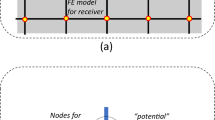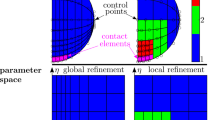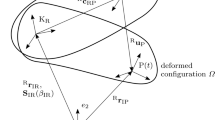Abstract
The examination of an unstructured finite volume method for structural dynamics is assessed for simulations of systematic impact dynamics. A robust display dual-time stepping method is utilized to obtain time accurate solutions. The study of impact dynamics is a complex problem that should consider strength models and state equations to describe the mechanical behavior of materials. The current method has several features. 1) Discrete equations of unstructured finite volume method naturally follow the conservation law. 2) Display dual-time stepping method is suitable for the analysis of impact dynamic problems of time accurate solutions. 3) The method did not produce grid distortion when large deformation appeared. The method is validated by the problem of impact dynamics of an elastic plate with initial conditions and material properties. The results validate the finite element numerical data.
Similar content being viewed by others
References
Bailey C, Cross M (1995). A finite volume procedure to solve elastic solid mechanics problems in three dimensions on an unstructured mesh. International Journal for Numerical Methods in Engineering, 38, 1756–1776.
Demirdzic I, Martinovic D (1993). Finite volume method for thermo-elasto-plastic stress analysis. Computational Methods Applied in Mechanical Engineering, 109, 331–349
Demirdzic I, Muzaferija S, Peric M (1994). Finite volume method for stress analysis in complex domains. International Journal for Numerical Methods in Engineering, 37, 3751–3766.
Demirdzic I, Muzaferija S, Peric M (1997). Benchmark solutions of some structural analysis problems using finite volume method and multi-grid acceleration. International Journal for Numerical Methods in Engineering, 40, 1893–1908.
Fallah N (2004). A cell vertex and cell centered finite volume method for plate bending analysis. Computational Methods Applied in Mechanical Engineering, 193, 3457–3470.
Fryer YD (1991). A control volume procedure for solving the elastic stress-strain equations on an unstructured mesh. Applied Mathematical Modeling, 15, 639–645.
Hattel JH, Hansen PN (1995). A control volume-based finite difference method for solving the equilibrium equations in terms of displacements. Applied Mathematical Modeling, 19, 210–243.
Idelsohn SR, Onate E (1994). Finite volumes and finite elements: “two good friends”. International Journal for Numerical Methods in Engineering, 37, 3323–3341.
Onate E, Cervera M, Zienkiewicz OC (1994). A finite volume method format for structural mechanics. International Journal for Numerical Methods in Engineering, 37, 181–201.
Slone AK, Bailey C, Cross M (2003). Dynamic solid mechanics using finite volume methods. Applied Mathematical Modeling, 27, 69–87.
Slone AK (2004). A finite volume unstructured mesh approach to dynamic fluid-structure interaction: an assessment of the challenge of predicting the onset of flutter. Applied Mathematical Modeling, 28, 239–311.
Taylor GA, Bailey C, Cross M (1995). Solution of the elastic/visco-plastic constitutive equations: a finite volume approach. Applied Mathematical Modeling, 19, 746–760.
Tielin Liu, Kaishin Liu, Jinxiang Zhang (2004). Unstructured grid method for stress wave propagation in elastic media. Computational Methods Applied in Mechanical Engineering 193, 2427–2452.
Wheel MA (1996). A geometrically versatile finite volume formulation for plane strain elastostatic stress analysis. Journal of Strain Analysis for Engineering Design, 31, 111–116.
Wheel MA (1997). A finite volume method for analyzing the bending deformation of thick and thin plates. Computational Methods Applied in Mechanical Engineering, 147, 199–208.
Wenke P, Wheel MA (2003). A finite volume method for solid mechanics incorporating rotational degrees of freedom. Computers and Structures, 81, 321–329.
Xia GH (2007). A 3D implicit unstructured-grid finite volume method for structural dynamics. Computational Methods Applied in Mechanical Engineering, 40, 299–312.
Author information
Authors and Affiliations
Corresponding author
Additional information
Weidong Chen was born in 1966. He is a professor and doctoral supervisor at Harbin Engineering University. His research interests are structural reliability, optimal design and explosion mechanics.
Yanchun Yu was born in 1984. She is a doctoral candidate at Harbin Engineering University, majoring in structural impact dynamics.
Rights and permissions
About this article
Cite this article
Chen, W., Yu, Y. An unstructured finite volume method for impact dynamics of a thin plate. J. Marine. Sci. Appl. 11, 478–485 (2012). https://doi.org/10.1007/s11804-012-1158-6
Received:
Published:
Issue Date:
DOI: https://doi.org/10.1007/s11804-012-1158-6




